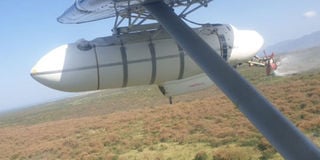More locusts invade Meru-Isiolo border posing threat to crops

Aerial spraying of desert locusts in Kipsing on the border of Isiolo and Laikipia counties on January 13, 2020. More desert locust swarms have invaded parts of the Meru-Isiolo border. PHOTO | WAWERU WAIRIMU | NATION MEDIA GROUP
What you need to know:
- Ntangilia and Mula are major food baskets for residents of Tigania.
- Mr Langat said minimal damage was caused in Ndumuru since the destructive insects did not stay there for long.
- Ms Mutiga said the locust swarms that had invaded Ndumuru and Mariara on Saturday have been suppressed.
More desert locust swarms have invaded parts of the Meru-Isiolo border even as the insects that settled in the area last Saturday were contained through aerial spraying.
New swarms have settled in Ndumuru (Igembe North), Ntangilia and Mula in Tigania East, posing a threat to crops.
Ntangilia and Mula are major food baskets for residents of Tigania, with some sections of the area having irrigation projects where vegetables are grown.
Igembe North Deputy County Commissioner Charles Langat said minimal damage was caused in Ndumuru since the destructive insects did not stay there for long.
VEGETATION INTACT
“The locusts mostly settled on acacia trees. The vegetation is intact but we are on the lookout for new swarms to ensure a timely response,” Mr Langat said.
Meru County Agriculture Executive Carol Mutiga said the locust swarms that had invaded Ndumuru and Mariara on Saturday had been suppressed.
She said the locusts did not cause much damage since most had died following the spraying while the rest of the swarms were immobile due to the effects of the pesticide.
“We are still doing aerial and ground surveillance but the swarms that were in Meru have been contained,” Ms Mutiga said.
By Sunday afternoon, the locust swarms had invaded Mariara, Kipsing and Sereolipi in Meru, Isiolo and Samburu counties respectively where spraying was ongoing.
CLOUDY WEATHER
Sources close to the operation said that aerial spraying that was scheduled to go on for three days was interrupted on Monday morning due to rains and cloudy weather.
Meru, Tharaka-Nithi, Isiolo, Laikipia and Samburu counties, with the support of the Northern Rangeland Trust, Lewa Conservancy and private firms from the region, have formed a joint team to fight the desert locusts.
Dr Muo Kasina, the chairman of the Entomological Society of Kenya, said they are yet to establish the economic damage caused by the desert locusts in the affected areas.





